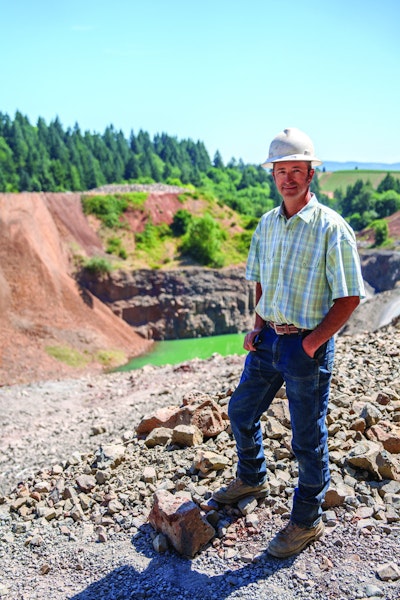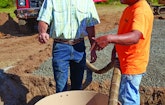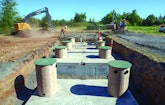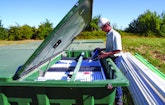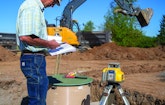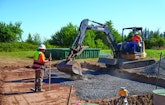
Rick Jonas visits with John Deere 470 excavator operator Don Stephenson at the quarry owned by A-Affordable Septic Service.
Interested in Systems/ATUs?
Get Systems/ATUs articles, news and videos right in your inbox! Sign up now.
Systems/ATUs + Get AlertsRick Jonas and his team install about 80 onsite treatment systems a year and pump up to 800 septic tanks for homes in Oregon’s Willamette Valley, stretching 150 miles south from Portland and where 70% of the state’s residents live.
But residential systems are not the main focus of the business. A-Affordable Septic Service in Canby concentrates on two to three large-scale systems per year, mostly for county and state parks and vineyards. The company also digs reservoirs from which vineyards draw water for irrigation.
“We somewhat specialize in the bigger systems in Oregon,” says Jonas, who started A-Affordable in 1998. “There are just a few of us who do them, and we typically get a shot at building every one. Over the years we’ve built up our crews to where it’s easier for us to work for one customer for a month than for 20 customers in a month.
“That’s the business model we’ve drifted to. We used to do three drainfields a week, Monday through Wednesday, and then I would go back on Thursday and Friday and finish those jobs up. But permitting is getting to be slower, so that it’s tougher to line those projects up to where we can be efficient. We use the residential systems to fill the gaps in between the bigger projects.”
RAMPING UP
After high school, Jonas attended Central Oregon Community College for two years but decided not to pursue a four-year degree. He bought a backhoe and dump truck, went to work on his own, and in 2000 moved to the Willamette Valley. He worked solo for a couple more years before hiring his first employee. By 2011 the company had grown to roughly its present size.
The business has come a long way since Jonas launched it, digging for drainfields and doing general excavation. He now has 21 team members, a large inventory of equipment, and a thriving rock-crushing business.
The company operates 21 excavators ranging from John Deere 17G units (about 3,500 pounds) to Hitachi 800 units (165,000 pounds). A newly delivered John Deere 470P will operate in the rock quarry and large reservoir projects.
“We rely on Bobcat and John Deere skid-steers for moving gravel to drainfield trenches and general clean-up after inspections,” says Jonas. In summer we use dozers for mass grading and backfilling. GPS installed in them speeds up our production up significantly when paired with the right project.
“On projects with difficult access, either wet areas or steep slopes, we use an 8-cubic-yard Komatsu CD110 tracked dump truck with a rotating carriage. On some sites due to steep terrain or other obstacles, we can directional bore utilities with our JT5 and JT20 drills manufactured by Ditch Witch. Our dump trucks are Kenworths and Peterbilts from 1998 to 2007. I like the older trucks, and we keep them well maintained.”
BIG TERRITORY
Thus equipped, Jonas will take on large projects anywhere in the state, but about 75% of the work is within seven counties in the valley. Oregon’s climate is diverse — snowy winters in the east, abundant rain in the west.
“We live right between the Coast Range and the Cascade Mountains,” says Jonas. “Our elevation in the valley is about 150 feet. From our yard we can go about 20 miles east and be at the foothills of the Cascades, and it’s really rocky with timber. We can go about 30 miles west and be in the Coast Range.
“The soils in the valley are typically silt-loam and clay, with pockets of sand. On average we have about two feet of topsoil, and then we get into heavier clays. Depending on where we are the topsoil gets deeper, but typically it’s rather shallow. We have lots of clay.”
Residential onsite systems fall into two basic types: 450 gpd conventionals with a concrete tank and 375 feet of rock-and-pipe drainfield and, where there are challenges with soils, water table or lot size, systems with aerobic treatment units and drainfields about one-third the conventional size. The ATUs of choice are AdvanTex AX20-RTs because the manufacturer (Orenco Systems) is nearby and provides reliable support, Jonas notes.
For drainfield media Jonas prefers crushed rock for its durability. He uses lightweight EZflow media (Infiltrator Water Technologies) on difficult-to-access sites and installs low-profile chambers (also Infiltrator) in a low-pressure distribution system using AX20-RT treatment units. Tanks up to 3,000 gallons are precast locally by Waite Concrete Products. Tanks larger than that are typically fiberglass units (Xerxes).
For system designs, Jonas relies on companies that include Cascade Earth Sciences and Environmental Management Systems, along with Aqua Resources for vineyard projects.
LARGER SCALE
The large treatment systems often are public-sector jobs won through competitive bidding; they typically take one to three months to complete. In 2020 A-Affordable rebuilt the entire treatment system for Champoeg State Heritage Area. That 20,000 gpd system used six HighStrengthFAST treatment units (BioMicrobics) with 3,600 feet of drainfield trench.
Last winter, crews installed a 10,000 gpd system for Clackamas County’s Eagle Fern Park with two AdvanTex AX100 treatment units. The four 3,000-gallon concrete septic tanks were placed below the water table; a pipeline installed by directional boring carries treated effluent about 2,000 feet and up the side of a mountain to the drainfield.
One major project for summer 2023 was a 10,500 gpd system for Clackamas County’s Fischer’s Forest Park with three AX100 units and some 50,000 feet of subsurface drip irrigation tubing.
Meanwhile, in the valley’s booming wine industry, A-Affordable has developed relationships with vineyards leading to work that includes large-scale treatment systems. They include a 7,000 gpd system in 2019 for Stoller Family Estates with four HighStrengthFAST units.
Vineyard work also calls for process waste treatment systems. Two years ago the company installed a system with two 20,000-gallon fiberglass settling tanks (Xerxes). “All the grape skins and other waste is delivered by gravity to the first settling tank, which contains screenings baskets,” says Jonas. “Duplex pumps in that tank send the liquid to another settling tank, after which it is surface-applied by a pop-up sprinkler system.”
Jonas and his team learned that side of the business through on-the-job training: “I read about it, and we work with some very good designers who have helped us along the way. We found what works and what doesn’t. We honed our skills by trial and error.”
VINEYARD IRRIGATION
Reservoirs for vineyards are another line of business. “Oregon has been in a drought,” Jonas says. “A lot of vineyards are building reservoirs that capture runoff to irrigate their young vines. That work typically keeps one or two of our crews busy in the summer.”
Reservoirs generally range from 2 to 5 acres, about 10 feet deep, containing 9 to 12 acre-feet of water. “The vineyards are comfortable with what we charge. We’ve done projects with them before, and they just hire us to do the jobs.”
The rock-crushing operation comes into play on those jobs, as the vineyard operators need gravel for access roads and for other development around facilities such as wine-tasting rooms and production buildings.
Jonas learned about rock crushing from his father who was in that business in eastern Oregon. He bought a portable rock-crushing plant about 13 years ago and operates under a lease with the owner of the quarry: “We own the crushing equipment but not the property. We pay a royalty for every ton of rock that leaves that property.” The volume is significant — some 500,000 tons per year of blue basalt, a very hard and fine-grained igneous rock.
“We are set up in a quarry that is right in the middle of wine country,” Jonas says. “We crush for the vineyards, for farmers and dairies in the area and for highway jobs. I have a very good crushing staff and a great crushing superintendent in Casey Johnson.”
A-Affordable uses rock from the quarry for a significant share of its onsite work but buys from other sources when it is more cost-effective to do so.
TREATING PEOPLE RIGHT
It’s quality, not price, that keeps the business thriving. Repeat customers and word of mouth keep the work schedule full. “When I started A-Affordable Septic Service in the late 1990s, everybody had a phone book and I wanted to be at the top of the listings,” Jonas says. “Now nobody uses the phone book, and we hardly advertise at all.
“We can hardly do the amount of work that comes in the door. We work with a dozen or so builders who build two to five houses a year. The Willamette Valley is a pretty large area but it’s a small group of people who do what we do. A reputation for doing a good job, for doing what’s right, has helped us along the way.”
As an example of “what’s right,” Jonas cites a job in which a crew installed a drainfield not knowing that it was over a spring that had dried up in summer: “We put in the drainfield; it failed. It wasn’t our fault, but it certainly wasn’t the customer’s fault. So the next summer we put a new drainfield in.”
The pumping side of the business helps feed the installation side. The vacuum truck is a 2016 Peterbilt 348 with a 3,400-gallon steel tank fabricated by Pik Rite and a 475 cfm Masport pump. Operator Marty Fuller has been with the company for 18 years and has an eye for issues that can lead to assorted repairs as well as tank and drainfield replacements. He is just one member of an experienced team that keeps the company in a solid competitive position.
Angie Besso, operations manager, handles everything from insurance to contracts and daily coordination with employees, customers and vendors. Dessa Coleman handles accounts payable, septic installation invoicing, and permitting. Michelle Gooding’s duties include dispatch and fielding incoming calls.
Mike Hulett is septic installation superintendent and leader of most large installs. Joe Deloney installs most of the standard onsite systems. Fred Tice, superintendent, handles most vineyard jobs. Arny Tepole specializes in difficult and technical plumbing projects. Jake Wright, foreman and truck driver, helps with truck dispatching and gravel deliveries.
Darrel Bigelow is a truck driver and lowboy operator who hauls most of the equipment to and from projects.
Truck drivers, laborers and operators include Emilio Chavez, Miguel Ortega, Jason Ewing,
Charles Jackson, Don Stephenson, Reid Potter, Sal Corona, Scott McGlaughlin, Ron Findley and Dion Miller. Lyle Wolf is head mechanic and John Palmer is a welder and mechanic.
STAYING SHARP
Jonas makes sure all team members are well trained. “Everybody we hire who doesn’t know this business first works with an older crew for a length of time that depends on their aptitude and how fast they’re learning,” Jonas says. “A lot of times on the install crews I personally work with new people on a few jobs to see how well they’re progressing.”
Jonas and team members also attend conferences sponsored by country regulators, the Oregon Onsite Wastewater Association, and others.
Looking ahead, Jonas holds out hope that his daughters Brooke (now in college) and Elsie (in high school) will take over for him one day: “We also have got some key people who will likely step up so this place will continue to run after I’m gone. Right now we don’t have any concrete plans. I’m young, I’m still in good enough health, and I like what I do.
“The business has been good to us. In the bad times everybody still needs indoor plumbing, so it has been recession-proof.”
